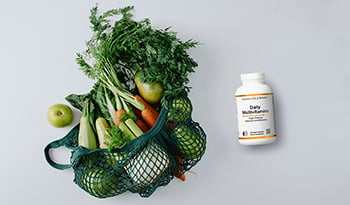5 Common Micronutrient Deficiencies In The Developing World
DISCLAIMER:This blog does not intend to provide diagnosis...
- In this article:
- Nutritional Deficiencies: Macronutrients vs. Micronutrients
- 1. Folate (Vitamin B9)
- 2. Vitamin A
- 3. Iron
- 4. Zinc
- 5. Iodine

While many countries worldwide have made significant progress regarding access to clean water, sanitation, vaccination rates, nutrition, reduced infant mortality, lifespan extension, and healthcare technology, many still lack the basics. Most of these deficiencies affect countries with a low GDP or Gross Domestic Product, where most citizens live in poverty.
Nutritional Deficiencies: Macronutrients vs. Micronutrients
Malnutrition can result from the deficiency of two types, macronutrients and micronutrients.
Macronutrients
Macronutrients include protein, fats, and carbohydrates which are required for overall health and survival. Essentially, every food we eat consists of these three things in various proportions.
Proteins are made of amino acids and are the building blocks of our muscles and enzymes. Some are termed "essential," meaning we can only get them from the diet. Others termed "non-essential" our body can make.
Fat is required for brain health, cell integrity, and hormone synthesis. Certain fats are called "essential fatty acids" as we can only get them from the diet.
Lastly, there are carbohydrates, which ultimately break down into glucose to fuel the body. Ironically, these are not essential as the body can make glucose from amino acids and protein when not in the diet. Carbohydrates high in fiber (i.e., kale, greens) are not broken down into glucose. However, starchy carbohydrates ( i.e., potatoes) can easily break down into glucose.
Micronutrients
Micronutrients are vitamins and minerals needed by the body. They can't be made and must be consumed. When deficient, one can develop life-threatening health issues. Many trace minerals help the body's hormones and enzymes to function normally.
According to the World Health Organization (WHO), 45% of deaths in children worldwide are due to nutritional deficiencies. Third-world countries are the most affected.
A deficiency of macronutrients (protein, fats, and carbohydrates) leads to muscle wasting, a deficiency in the below micronutrients is also the main contributor to poor health and is what we will discuss in this blog.
Worldwide, folate, vitamin A, iron, iodine, and zinc are some of the most common deficiencies. Fortunately, they are also some of the most inexpensive nutrients and easiest to replete, so ensuring adequate intake can be done if a concerted effort is put in place.
1. Folate (Vitamin B9)
Folate is an important water-soluble vitamin for healthy cell division and proper nerve development. It is required to produce DNA, RNA, and amino acids adequately. Folic acid is a common form of vitamin B9 that is added to multivitamins and food. The word folate is derived from "foliage," a reference to green leafy vegetables and plant foods, where folate is found in abundance.
In the United States, up to 20% of teenage females do not get adequate amounts of folic acid. A 2017 European Journal of Clinical Nutrition study suggested up to 85% of women in the United Kingdom aged 16-49 are at risk for deficiency. Men and women from Asia, Europe, Africa, and the Middle East are at greater risk.
Maternal intake of folic acid may reduce the risk of autism in babies, according to a 2018 study in JAMA Psychiatry. Prenatal vitamins contain folate and, when taken, can help prevent neural tube defects and cleft lips and palates in babies. According to many health professionals, women of childbearing age should take folate routinely.
Risk Factors of Folate Deficiency
- Diet low in green leafy vegetables
- Certain medications (triamterene, methotrexate medications, some seizure medications)
- Routine or excessive alcohol intake
- Malabsorption syndromes (leaky gut, celiac disease, Crohn's disease, ulcerative colitis)
Symptoms of Deficiency
- Neural tube defects in the baby (if the mother is deficient during conception and early pregnancy)
- Neuropathy and nerve impairment
- Depression
- Anemia, megaloblastic
- Nerve impairment and memory loss
- Elevated homocysteine (increased risk for heart attack, stroke, and blood clots)
- Increased risk of certain cancers (colon, lung, pancreas, esophagus, bladder
Food Sources of Folate
- Vegetables (spinach, kale, cabbage)
- Beef and chicken
- Peas, beans, and lentils
- Nuts (hazelnuts, walnuts, peanuts)
- Seeds (flax seeds, chia seeds, sunflower seeds)
- Eggs
How to Address Folate Acid Deficiency
When the diet does not provide sufficient folate, folate or folic acid supplement should be considered. This is especially important in women of childbearing age. It can be consumed as an individual supplement, part of B-complex vitamin, or as part of a quality multivitamin or prenatal vitamin. The minimum dose is 400 mcg, and rarely is a dose of more than 1,000 mcg recommended. This is extremely important in pregnant and nursing mothers to help ensure the children have sufficient levels.
2. Vitamin A
Vitamin A is a powerhouse nutrient, yet it is the most common vitamin deficiency worldwide. It is a potent antioxidant that comes from two sources. In certain plants, there is beta-carotene, a precursor to vitamin A. The body then converts this to vitamin D. In meats, there is pre-formed vitamin A, which is ready to use once consumed.
When vitamin A is lacking in a person's diet, the results can be catastrophic, especially in children. Vitamin A is crucial for developing healthy vision, immune system strength, and future reproduction. According to WHO, more than 250 million preschool-aged children worldwide are deficient. Further, blindness due to vitamin A deficiency affects 2.8 million children under five. When one is deficient, the cornea becomes dry, resulting in cornea and retinal damage.
Women who are pregnant and deficient in vitamin A are at risk for night blindness, while the fetus without sufficient levels of vitamin A in the mom is at risk for developmental issues.
Risk Factors of Vitamin A Deficiency
- Diet low in milk, cheese, and eggs
- Inadequate intake of fruits (red bell pepper, pumpkins, tomatoes, apricots, cantaloupes, mango)
- Low intake of these vegetables (sweet potatoes, carrots, spinach, broccoli)
- Low intake of liver meat and certain seafood (king mackerel, salmon, bluefin tuna)
Many plant-based foods contain beta carotene (pro-vitamin A), the precursor to vitamin A. These carotenoids, as they are called, play an important role in overall health.
Symptoms of Vitamin A Deficiency
- Blindness and night blindness
- Diarrhea
- Dry, flaky skin
- Poor growth and development (in children)
- Increased risk of infections
- Increased risk of miscarriage
How to Address Vitamin A Deficiency
Consuming adequate vitamin A from one's diet is preferred. However, this is not always possible for many around the world.
Therefore, consuming a quality multivitamin with vitamin A is essential; in some cases, a separate vitamin A supplement may be needed.
Vitamin A toxicity can occur when excessive amounts, 25,000 IU daily or more, of preformed vitamin A, are consumed. Cod Liver oil is also a great source of vitamin A.
Beta-carotene has no known toxic effects or upper limit when eaten as a food. However, when large amounts are consumed, some can develop a reversible orange color in their skin, a condition called beta-carotenemia. This is reversible when intake is reduced.
NOTE: Smokers should be extra cautious about supplementing with vitamin A alone as it may increase lung cancer risk, according to some studies. Consult a physician first.
3. Iron
Iron is the most abundant mineral on earth. It is a chemical element with the periodic table's Fe (ferrous) symbol. However, the average person has only 3-4 grams (1 teaspoon) in the body, most of it in hemoglobin. The rest is in the muscles, bone marrow, liver, and spleen. Despite this relatively small amount in the body, iron deficiency anemia is estimated to affect two billion people worldwide, mostly women and children.
Iron is crucial for the production of hemoglobin, which, when low, a person is diagnosed with iron-deficient anemia. Low iron in children can result in growth retardation.
Risk Factors for Iron Deficiency
- Babies born to mothers who are iron deficient
- Diets low in iron-rich foods (meats, poultry, spinach, peas, green beans, coconut, dried fruits)
- Intestinal issues (poor absorption, leaky gut, frequent diarrhea, Crohn's disease, ulcerative colitis, etc.)
- Bleeding (menstrual bleeding, gastrointestinal bleeding, or injury)
Iron in animal-based foods is better absorbed and is known as heme iron. Iron from plant-based foods is called non-heme iron.
Symptoms of Iron Deficiency
- Pale color
- Fatigue (can be due to anemia or mitochondrial dysfunction due to the inability to generate adequate energy or ATP)
- Fussiness and irritability
- Fast heart rate
- Craving dirt or ice, a condition called pica
- Children may have cognitive issues and poor growth and development
How to Address Iron Deficiency
As long as the mother is not deficient, breast milk usually contains enough iron for a growing baby up to 6 months of age. Children not breastfed should consume iron-fortified formula. Ensuring the mother takes a multivitamin with iron is one of the best ways to ensure a breastfeeding child receives adequate nutrition.
If not breastfed, the WHO (World Health Organization) recommends supplementation with 2 mg/kg/day in children from 6 to 23 months of age if the diet does not already include fortified foods or if they live in a developing nation where the prevalence of anemia is 40% or more.
Young children and adults should consume iron-rich foods, including meats, poultry, and green leafy vegetables, if possible. A multivitamin with iron or a separate iron supplement should be considered if not possible.
4. Zinc
According to the Journal of Nutrition, almost 45% of Americans have inadequate zinc intake in their diets. Worldwide, more than 15% of people are zinc deficient. Children are adversely affected to an even greater degree.
Zinc also plays a vital role in brain health, where its levels are ten times greater than in the blood. Enzymes require zinc in the brain and throughout the body. Zinc is involved in over 300 biochemical reactions and is a critical component of over 2,000 proteins.
Symptoms of Zinc Deficiency
- Reduced or loss of taste sensation
- Decreased sense of smell
- Increased risk of infection
- Increased risk of intestinal infection
- Chronic diarrhea
- Skin dryness (dermatitis)
- Delayed growth in children
- Pregnant moms with low levels of zinc may increase the risk of autism in their offspring
- Low sperm count resulting in infertility
Best Food Sources of Zinc
The below foods (per 3 grams) are some of the richest sources of zinc. For obvious reasons, many of these foods are not easily accessible worldwide or may be culturally inappropriate.
- Oysters – 74 mg
- Beef Chuck Roast – 7 mg
- Alaska Crab – 6.5 mg
- Beef Patty – 3 mg
- Breakfast cereal – 3.5 mg
- Lobster – 3.4 mg
- Pork chop – 2.9 mg
- Baked Beans – (1/2 cup) 2.9 mg
- Chicken – 2.4 mg
- Fruit yogurt – (8 ounces) 1.9 mg
How to Address Zinc Deficiency
Ideally, zinc should be consumed by eating more of the foods listed above. However, that is not always possible. In that case, supplements should be considered. Zinc supplements come in many forms, including Zinc Picolinate, Zinc Gluconate, Zinc Bis-glycinate, and Zinc Citrate – these are the best absorbed. The usual dose is 10 mg to 25 mg daily. A quality multivitamin with zinc can also be considered.
5. Iodine
Iodine is an essential trace mineral. Iodine is represented by the Symbol I on the periodic table. In addition to thyroid function, iodine has many other important roles in human health. Iodine deficiency disorders affect 740 million people worldwide, making it one of the most common.
Risk Factors for Iodine Deficiency
- Low dietary intake
- Pregnancy (the baby extracts it from the mother)
- Tobacco use and Alcohol use
Symptoms of Iodine Deficiency
- Goiter (fullness of the neck)
- Hypothyroidism (underactive thyroid)
- Miscarriage (occurs when mom and fetus are deficient)
- Stillbirth (mom and fetus are severely deficient)
- Reduced intelligence / Lower IQ (Intelligence Quotient)
- Short stature/ Impaired growth in children
- Delayed puberty onset in both boys and girls
How to Address Iodine Deficiency
Increasing the consumption of eggs and dairy products such as milk, yogurt, and cheese can help ensure the intake of iodine.
Using iodine-fortified salt for flavoring is also helpful. Sea vegetables such as kelp, dulse, and nori are rich in iodine. Fish such as cod and tuna are also great sources of iodine.
When this is not possible, a multivitamin with iodine should be consumed. Infants to six years of age need a minimum of 90 mcg per day- if a mother is breastfeeding, supplementation can help meet these needs. Children ages 6 to 12 need 120 mcg per day. Those 13 and older need at least 150 mcg of iodine, which is common in most multivitamins. Pregnant and lactating women need about 300 mcg daily, about double the recommended adult dose.
References:
- https://www.who.int/health-topics/micronutrients#tab=tab_1 , Accessed October 7, 2022
- Müller O, Krawinkel M. Malnutrition and health in developing countries. CMAJ. 2005 Aug 2;173(3):279-86. doi: 10.1503/cmaj.050342. PMID: 16076825; PMCID: PMC1180662
- Bailey RL, Dodd KW, Gahche JJ, et al. Total folate and folic acid intake from foods and dietary supplements in the United States: 2003-2006. Am J Clin Nutr 2010;91:231-7
- European Journal of Clinical Nutrition. 2017 Feb;71(2):159-163. doi: 10.1038/ejcn.2016.194. Epub 2016 Oct 12.
- Levine SZ, Kodesh A, Viktorin A, et al. Association of maternal use of folic acid and multivitamin supplements in the periods before and during pregnancy with the risk of autism spectrum disorder in offspring. JAMA Psychiatry 2018;75:176-84.
- He H, Shui B. Folate intake and risk of bladder cancer: a meta-analysis of epidemiological studies. International Journal Food Science Nutrition 2014;65:286-92.
- https://www.who.int/data/nutrition/nlis/info/vitamin-a-deficiency#:~:text=In%20its%20more%20severe%20forms,months%20of%20losing%20their%20sight accessed October 9, 2022
- Nutrition and Cancer. 2009;61(6):767-74. doi: 10.1080/01635580903285155. Lung Cancer risk and Beta-Carotene
- Díaz JR, de las Cagigas A, Rodríguez R. Micronutrient deficiencies in developing and affluent countries. Eur J Clin Nutr. 2003 Sep;57 Suppl 1:S70-2. doi: 10.1038/sj.ejcn.1601820. PMID: 12947458.
- Hurrell R, Egli I. Iron bioavailability and dietary reference values. Am J Clin Nutr 2010;91:1461S-7S.
- Hoes MF, Grote Beverborg N, Kijlstra JD, et. al. Iron deficiency impairs contractility of human cardiomyocytes through decreased mitochondrial function. Eur J Heart Fail. 2018 May;20(5):910-919.
- https://ods.od.nih.gov/factsheets/iron-healthprofessional/#h7 accessed October 9, 2022
- Ciubotariu D, Ghiciuc CM, Lupușoru CE. Zinc involvement in opioid addiction and analgesia – should zinc supplementation be recommended for opioid-treated persons? Substance Abuse Treatment, Prevention, and Policy. 2015;10:29. doi:10.1186/s13011-015-0025-2.
- Mocchegiani, E.; Bertoni-Freddari, C.; Marcellini, F.; Malavolta, M. Brain, aging and neurodegeneration: Role of zinc ion availability. Prog. Neurobiol. 2005, 75, 367–390.
- Andreini, C.; Banci, L.; Bertini, I.; Rosato, A. Counting the zinc-proteins encoded in the human genome. J. Proteome Res. 2006, 5, 196–201.
- Vela G, Stark P, Socha M, Sauer AK, Hagmeyer S, Grabrucker AM. Zinc in Gut-Brain Interaction in Autism and Neurological Disorders. Neural Plasticity. 2015;2015:972791. doi:10.1155/2015/972791.

 By Dr. Eric Madrid, M.D.
By Dr. Eric Madrid, M.D.


